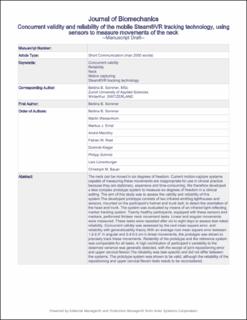Please use this identifier to cite or link to this item:
https://doi.org/10.21256/zhaw-18306Full metadata record
| DC Field | Value | Language |
|---|---|---|
| dc.contributor.author | Sommer, Bettina B. | - |
| dc.contributor.author | Weisenhorn, Martin | - |
| dc.contributor.author | Ernst, Markus J. | - |
| dc.contributor.author | Meichtry, André | - |
| dc.contributor.author | Rast, Fabian M. | - |
| dc.contributor.author | Kleger, Dominik | - |
| dc.contributor.author | Schmid, Philipp | - |
| dc.contributor.author | Lünenburger, Lars | - |
| dc.contributor.author | Bauer, Christoph M. | - |
| dc.date.accessioned | 2019-09-28T09:40:11Z | - |
| dc.date.available | 2019-09-28T09:40:11Z | - |
| dc.date.issued | 2019-09 | - |
| dc.identifier.issn | 0021-9290 | de_CH |
| dc.identifier.issn | 1873-2380 | de_CH |
| dc.identifier.uri | https://digitalcollection.zhaw.ch/handle/11475/18306 | - |
| dc.description.abstract | The neck can be moved in six degrees of freedom. Current 3D-optoelectronic motion-capture systems capable of measuring these movements are inappropriate for use in clinical practice because they are stationary, expensive and time-consuming. We therefore developed a less complex 3D-tracking technology based on Steam®VR to measure six degrees of freedom in a clinical setting. The aim of this study was to assess the validity and reliability of this system. The developed prototype consists of two infrared-emitting lighthouses and sensors, mounted on the participant’s helmet and trunk belt, to detect the orientation of the head and trunk. The system was evaluated by means of an infrared light-reflecting marker tracking system. Twenty healthy participants, equipped with these sensors and markers, performed thirteen neck movement tasks. Linear and angular movements were measured. These tasks were repeated after six to eight days to assess test-retest reliability. Concurrent validity was assessed by the root mean square error, and reliability with generalizability theory. With an average root mean square error between 1.2 and 2.0° in angular and 0.4–0.5 cm in linear movements, the prototype was shown to precisely track these movements. Reliability of the prototype and the reference system was comparable for all tasks. A high contribution of participant’s variability to the observed variance was generally detected, with the exception of joint repositioning error and upper cervical flexion. The reliability was task-specific and did not differ between the systems. The prototype system was shown to be valid, although the reliability of the repositioning and upper cervical flexion tests needs to be reconsidered. | de_CH |
| dc.language.iso | en | de_CH |
| dc.publisher | Elsevier | de_CH |
| dc.relation.ispartof | Journal of Biomechanics | de_CH |
| dc.rights | Licence according to publishing contract | de_CH |
| dc.subject.ddc | 616.7: Krankheiten des Bewegungsapparates und Orthopädie | de_CH |
| dc.title | Concurrent validity and reliability of a mobile tracking technology to measure angular and linear movements of the neck | de_CH |
| dc.type | Beitrag in wissenschaftlicher Zeitschrift | de_CH |
| dcterms.type | Text | de_CH |
| zhaw.departement | Gesundheit | de_CH |
| zhaw.organisationalunit | Institut für Physiotherapie (IPT) | de_CH |
| dc.identifier.doi | 10.1016/j.jbiomech.2019.109340 | de_CH |
| dc.identifier.doi | 10.21256/zhaw-18306 | - |
| zhaw.funding.eu | No | de_CH |
| zhaw.originated.zhaw | Yes | de_CH |
| zhaw.pages.start | 109340 | de_CH |
| zhaw.publication.status | submittedVersion | de_CH |
| zhaw.publication.review | Peer review (Publikation) | de_CH |
| zhaw.funding.zhaw | Valedo Nackentherapie | de_CH |
| zhaw.author.additional | No | de_CH |
| Appears in collections: | Publikationen Gesundheit | |
Files in This Item:
| File | Description | Size | Format | |
|---|---|---|---|---|
| 2019_Sommer_etal_ValedoNeck_prePrint_.pdf | Submitted Version | 1.04 MB | Adobe PDF |  View/Open |
Show simple item record
Sommer, B. B., Weisenhorn, M., Ernst, M. J., Meichtry, A., Rast, F. M., Kleger, D., Schmid, P., Lünenburger, L., & Bauer, C. M. (2019). Concurrent validity and reliability of a mobile tracking technology to measure angular and linear movements of the neck. Journal of Biomechanics, 109340. https://doi.org/10.1016/j.jbiomech.2019.109340
Sommer, B.B. et al. (2019) ‘Concurrent validity and reliability of a mobile tracking technology to measure angular and linear movements of the neck’, Journal of Biomechanics, p. 109340. Available at: https://doi.org/10.1016/j.jbiomech.2019.109340.
B. B. Sommer et al., “Concurrent validity and reliability of a mobile tracking technology to measure angular and linear movements of the neck,” Journal of Biomechanics, p. 109340, Sep. 2019, doi: 10.1016/j.jbiomech.2019.109340.
SOMMER, Bettina B., Martin WEISENHORN, Markus J. ERNST, André MEICHTRY, Fabian M. RAST, Dominik KLEGER, Philipp SCHMID, Lars LÜNENBURGER und Christoph M. BAUER, 2019. Concurrent validity and reliability of a mobile tracking technology to measure angular and linear movements of the neck. Journal of Biomechanics. September 2019. S. 109340. DOI 10.1016/j.jbiomech.2019.109340
Sommer, Bettina B., Martin Weisenhorn, Markus J. Ernst, André Meichtry, Fabian M. Rast, Dominik Kleger, Philipp Schmid, Lars Lünenburger, and Christoph M. Bauer. 2019. “Concurrent Validity and Reliability of a Mobile Tracking Technology to Measure Angular and Linear Movements of the Neck.” Journal of Biomechanics, September, 109340. https://doi.org/10.1016/j.jbiomech.2019.109340.
Sommer, Bettina B., et al. “Concurrent Validity and Reliability of a Mobile Tracking Technology to Measure Angular and Linear Movements of the Neck.” Journal of Biomechanics, Sept. 2019, p. 109340, https://doi.org/10.1016/j.jbiomech.2019.109340.
Items in DSpace are protected by copyright, with all rights reserved, unless otherwise indicated.